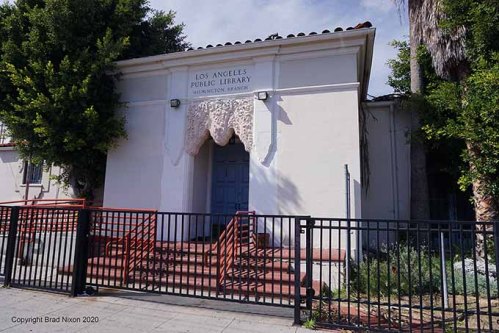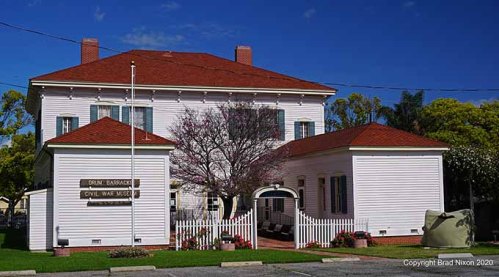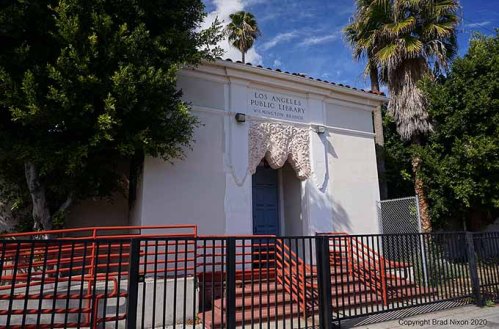It’s National Library Week. Although I can’t travel far during the current pandemic, I visited a nearby architectural gem without violating the social distancing rules: almost a “drive-by,” but I was able to get out of the car to shoot some photos on a quiet street.
In a recent blog post, I wrote about the surviving structure from Civil War era Camp Drum, Drum Barracks, in Wilmington, California, constructed 1862-63.
You’re excused if Wilmington isn’t a familiar California place name.
In the mid 19th century, Wilmington was an independent city, larger than Los Angeles proper, home of the newly established Port of Los Angeles. Annexed by Los Angeles in 1909 — in order to gain more control over the port and its commerce, as well as one of the richest oil fields in the U.S. — Wilmington now has about 54,000 residents in 10 square miles.
While Wilmington’s citizens weren’t unanimously in favor of annexation, there were advantages.
One addition to the town, arriving in 1927, was an attractive new branch of the Los Angeles Public Library.
Designed by W. E. McAllister in a version of Spanish Colonial Revival, it’s small but stylish, set on the corner in a quiet residential neighborhood.

Obscured now by palms and possibly one of Wilmington’s trademark camphor trees (left, above), the one-story building has side wings to left and right of the central block extending away from the street.
The highly stylized entablature or frieze over the entrance is probably molded concrete. Whether or not the mold was custom-designed for this structure, I’ve been unable to determine.
This is not one of six Carnegie libraries built in Los Angeles in 1911, two of which I’ve written about at the following links: Lincoln Heights and Cahuenga branches.
Instead, the growing size, population and reach of Los Angeles was served by a steadily expanding public library system that today encompasses the LA Central Library and 72 branches.
This structure is no longer a library, although there is still a Wilmington branch library, located a few blocks away, opened in 1988. This original building now serves — as do innumerable old library buildings across the U.S. — as a community center. It, along with a number of Los Angeles branch libraries, is on the National Register of Historic Places.
For ways to engage with your local library during the pandemic stay at home, please see my previous post at this link.
Seeing the Former Wilmington Branch.
The building is at 309 W Opp St. on the NW corner of W Opp and N Fries. Bear in mind that there’s residential curb parking. Please do not block someone’s driveway.
Licensable, high resolution versions of some photographs in this post, and select images from other Under Western Skies posts are available on Shutterstock.com. Click on the linked photos, or CLICK HERE to view the Underawesternsky photo portfolio.
© Brad Nixon 2020



The visual of the decoration above the doors must have shaped my perception. When you wrote that the ‘wings’ on either side were obscured, I started looking for angel or phoenix wings. Once I figured it out, I decided to pour another cup of coffee.
LikeLiked by 1 person
By: shoreacres on April 22, 2020
at 4:39 am
Hmm … or perhaps the writer should reconsider his phrasing and make clear what sort of wings he’s referencing. Thank you.
LikeLike
By: Brad Nixon on April 22, 2020
at 7:16 am
The website askart.com offers information about the artist: “Rudolph Parducci was born in Pisa, Italy, on January 11, 1899. Parducci came to the United States in 1906. He was working in New York City in 1920 as a model maker for a statue factory and continued as such while in Grosse Point, Michigan, in 1928-30. He moved to Los Angeles during the Depression and was employed by the Federal Art Project in 1938. He died there on June 25, 1973.”
LikeLiked by 2 people
By: Steve Schwartzman on May 1, 2020
at 1:01 pm
Thank you very much, Steve. I’m pleased to have that information, and may add a bit to the blog post. Have a great day.
LikeLike
By: Brad Nixon on May 1, 2020
at 3:58 pm
Hello— Steve (or Brad)– wondering if you can supply the askart.com link that indicates that Rudolph Parducci was the sculptor on the frieze? The only askart link I’ve read doesn’t give those details– maybe there’s another one?
Parducci was a New Deal sculptor in CA– created a piece still on display at Gardena postoffice. Before that, he was an architectural sculptor in several other states– and after the New Deal, he sculpted props for the film studios and the original Dumbo (with hinged ears) at Disneyland.
LikeLike
By: El Dub on December 27, 2021
at 6:32 pm
El Dub, I will reply. Just take me about a day. Please bear with me. I’ve seen Mr. Parducci’s work at Gardena. In the article about Wilmington, I do not attribute the freize work to him, but I need to read it more carefully. I’m pleased to hear from you, and look forward to learning more about Mr. Parducci from you. Thanks.
LikeLike
By: Brad Nixon on December 27, 2021
at 6:42 pm
Dear Brad– many thanks for your quick response. Understood that it was Steve who made the suggestion. Just didn’t want to leave you out of the discussion since this is your post. 🙂
I look forward to learning anything new you can share about Rudolph Parducci’s work!
My family and I live in a mid-century modern home that was built (and partially designed) by Rudolph Parducci. He lived here with his wife– it includes a large north-facing sculpting studio where he worked. And includes one of his sculptures that he created for the home.
(I have spent many hours reading up on Rudolph, talking to his family members and Dale Carlson, an architectural historian, about his work– and am always looking for more information.)
Rudolph was an architectural sculptor, living in Michigan in 1927, and didn’t move to CA until after the Depression, so it seems unlikely that he would have been involved in the library frieze creation– but I was hoping that Steve might have more info to suggest otherwise.
Rudolph and his brother, Corrado, came to US from Italy as young children. They were part of the early 20th century NYC sculpting scene. His brother, Corrado, was the more “famous’ architectural sculptor. (He was discovered by & educationally sponsored by heiress/sculptor Gertrude Vanderbilt Whitney as a chid.) Corrado was commissioned by two prominent industrial archtects (Albert Kahn & George Mason) during the auto industry boom in the 20s– Corrado’s responsible for architectural sculptures on most of the big buildings in this city. Rudolph worked alongside his brother on many of the big projects in Detroit and other parts of Michigan.
Besides his work creating New Deal sculpture in CA, Rudolph was involved in many other solo projects in other states– he created architectural sculptures for the art deco Louisianna State Capitol Building in Baton Rouge (a U.S. National Historic Landmark) and religious sculpture for St. Francis Xavier Church in Pheonix.
He was also responsible for creating many iconic sculpted pieces for film studios. Besides sculpting the original Dumbo while working for Disney Studios, his granddaughter tells me he created the mask for 1943 Phantom of the Opera film and the staircase in American in Paris; she reports that Rudolph was also involved in creating sculpted pieces for Creature from the Black Lagoon.
(Rudolph’s son and granddaughter told me that Rudolph was a shy, mild-mannered & behind the scenes guy, and didn’t seek a lot of attention, so he did not receive a lot of credit for all of his work.)
Thanks for engaging!
LikeLike
By: El Dub on December 28, 2021
at 11:28 am
Thank you. More to say.
LikeLike
By: Brad Nixon on December 28, 2021
at 10:51 pm
Apologies to Phoenix on the misspell. :~)
LikeLike
By: El Dub on December 31, 2021
at 12:26 pm